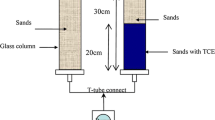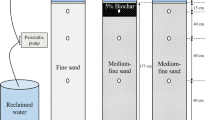Abstract
Biological clogging in porous media was an important concern in the design of bio-augmented permeable reactive barriers (Bio-PRBs) that were used to remediate groundwater with dense non-aqueous phase liquids (DNAPLs). Here, we used laboratory sandbox experiments to develop and calibrate reactive transport models (C1 and C2) simulating 1,1,1-trichloroethane (1,1,1-TCA) change in heterogeneous saturated porous media. The routine (1,1,1-TCA chain kinetic reactions) and subroutine (the relationship between hydraulic conductivity (K) and time (t)) were included in the model computer code. The simulation results suggested that the model C1 had the applicability for simulating contaminant transport and fate in bio-augmented flow field. By using the model C1 which was suitable for constant K condition, the performance of different types of Bio-PRBs was evaluated, and the regularity of contaminants chain kinetic reactions in different heterogeneous saturated porous media was obtained. The results demonstrated that Bio-PRBs in immobilized microorganism (IM) protocol were more superior to Bio-PRBs in free microorganism (FM) protocol. In addition, by using the model C2 (updated model C1) which was suitable for decreasing K condition, the different and optimized regularity of contaminants transport and transformation was obtained. The results showed that microbial growth which further decreased K was beneficial to preventing the transport of contaminants and accelerating the transformation of contaminants. However, the negative effects of biological clogging on hydraulic conductivity and relative hydraulic conductivity ratio in FM Bio-PRBs were significantly stronger than that in IM Bio-PRBs. Deploying IM Bio-PRBs for groundwater remediation would be much more efficient and meet the design criteria. The research work had guiding significance to engineering and provided consultation for designing and optimizing Bio-PRBs system. To make the design and optimization of Bio-PRBs system convenient, it was very essential to choose the suitable mathematical model (C1 or C2).







Similar content being viewed by others
References
Aiello R, Bagarello V, Barbagallo S (2016) Evaluation of clogging in full-scale subsurface flow constructed wetlands. Ecol Eng 95:505–513
Bear J, Verruijt A (1987) Modeling groundwater flow and pollution. D. Reidel Publishing Company
Berlin M, Suresh Kumar G, Nambi IM (2014) Numerical modeling of biological clogging on transport of nitrate in an unsaturated porous media. Environ Earth Sci 73:3285–3298
Cheng Z, Gao B, Xu H, Sun Y (2016) Effects of surface active agents on DNAPL migration and distribution in saturated porous media. Sci Total Environ 571:1147–1154
Ebigbo A, Helmig R, Cunningham AB, Class H, Gerlach R (2010) Modelling biofilm growth in the presence of carbon dioxide and water flow in the subsurface. Adv Water Resour 33:762–781
Erto A, Bortone I, Di Nardo A, Di Natale M, Musmarra D (2014) Permeable adsorptive barrier (PAB) for the remediation of groundwater simultaneously contaminated by some chlorinated organic compounds. J Environ Manag 140:111–119
Essaid HI, Bekins BA, Cozzarelli IM (2015) Organic contaminant transport and fate in the subsurface: evolution of knowledge and understanding. Water Resour Res 51:4861–4902
Eykholt GR, Elder CR, Benson CH (1999) Effects of aquifer heterogeneity and reaction mechanism uncertainty on a reactive barrier. J Hazard Mater 68:73–96
Gavaskar AR (1999) Design and construction techniques for permeable reactive barriers. J Hazard Mater 68:41–71
Greskowiak J, Prommer H, Massmann G, Johnston CD (2005) The impact of variably saturated conditions on hydrogeochemical changes during artificial recharge of groundwater. Appl Geochem 20:1409–1426
Kildsgaard J, Engesgaard P (2001) Numerical analysis of biological clogging in two-dimensional sand box experiments. J Contam Hydrol 50:261–285
Kumar N, Millot R, Battaglia-Brunet F, Omoregie E (2016) Microbial and mineral evolution in zero valent iron-based permeable reactive barriers during long-term operations. Environ Sci Pollut Res Int 23:5960–5968
Li H, Qiu YF, Wang XL, Yang J (2017) Biochar supported Ni/Fe bimetallic nanoparticles to remove 1,1,1-trichloroethane under various reaction conditions. Chemosphere 169:534–541
Luo P, Bailey EH, Mooney SJ (2013) Quantification of changes in zero valent iron morphology using X-ray computed tomography. J Environ Sci 25:2344–2351
Marchesi M, Thomson NR, Aravena R, Sra KS (2013) Carbon isotope fractionation of 1,1,1-trichloroethane during base-catalyzed persulfate treatment. J Hazard Mater 260:61–66
Ndong LBB, Gu X, Lu S, Ibondou MP (2015) Role of reactive oxygen species in the dechlorination of trichloroethene and 1.1.1-trichloroethane in aqueous phase in UV/TiO2 systems. Chem Eng Sci 123:367–375
Ni Z, van Gaans P, Rijnaarts H, Grotenhuis T (2017) Combination of aquifer thermal energy storage and enhanced bioremediation: biological and chemical clogging. Sci Total Environ 613-614:707–713
Samso R, Garcia J, Molle P, Forquet N (2016) Modelling bioclogging in variably saturated porous media and the interactions between surface/subsurface flows: application to constructed wetlands. J Environ Manag 165:271–279
Scheutz C, Durant ND, Hansen MH, Bjerg PL (2011) Natural and enhanced anaerobic degradation of 1,1,1-trichloroethane and its degradation products in the subsurface--a critical review. Water Res 45:2701–2723
Seki K, Thullner M, Hanada J, Miyazaki T (2006) Moderate bioclogging leading to preferential flow paths in biobarriers. Ground Water Monit Remediat 26:68–76
Simsir B, Yan J, Im J, Graves D, Loffler FE (2017) Natural attenuation in streambed sediment receiving chlorinated solvents from underlying fracture networks. Environ Sci Technol 51:4821–4830
Snape I, Morris CE, Cole CM (2001) The use of permeable reactive barriers to control contaminant dispersal during site remediation in Antarctica. Cold Reg Sci Technol 32:157–174
Soleimani S, Van Geel PJ, Isgor OB, Mostafa MB (2009) Modeling of biological clogging in unsaturated porous media. J Contam Hydrol 106:39–50
Thullner M, Baveye P (2008) Computational pore network modeling of the influence of biofilm permeability on bioclogging in porous media. Biotechnol Bioeng 99:1337–1351
USEPA (1998) Permeable reactive barrier technologies for contaminant remediation. In: Agency USEP (Hrsg)
Wang W, Wu Y (2017) Combination of zero-valent iron and anaerobic microorganisms immobilized in luffa sponge for degrading 1,1,1-trichloroethane and the relevant microbial community analysis. Appl Microbiol Biotechnol 101:783–796
Wantanaphong J, Mooney SJ, Bailey EH (2006) Quantification of pore clogging characteristics in potential permeable reactive barrier (PRB) substrates using image analysis. J Contam Hydrol 86:299–320
Xin BP, Wu CH, Wu CH, Lin CW (2013) Bioaugmented remediation of high concentration BTEX-contaminated groundwater by permeable reactive barrier with immobilized bead. J Hazard Mater 244-245:765–772
Xu Z, Wu Y, Yu F (2012) A three-dimensional flow and transport modeling of an aquifer contaminated by perchloroethylene subject to multi-PRB remediation. Transp Porous Media 91:319–337
Zheng C, Bennett GD (2009) Applied contaminant transport modeling, 2th edn. Higher Education Press, Beijing
Acknowledgements
Data used in this article can be obtained from the lead author. We thank the Center Lab of School of Environmental Science and Engineering, Shanghai Jiao Tong University, and the anonymous reviewers for their thoughtful comments, which greatly improved the manuscript.
Funding
This work was supported by the National Natural Science Foundation of China (No. 41272261) and Science and Technology Commission of Shanghai Municipality (No. 15DZ1205803).
Author information
Authors and Affiliations
Corresponding author
Ethics declarations
Conflict of interest
The authors declare that they have no conflict of interest.
Additional information
Responsible editor: Marcus Schulz
Electronic supplementary material
ESM 1
(DOCX 3291 kb)
Rights and permissions
About this article
Cite this article
Wang, W., Wu, Y. Effects of biological clogging on 1,1,1-TCA and its intermediates distribution and fate in heterogeneous saturated bio-augmented permeable reactive barriers. Environ Sci Pollut Res 25, 28628–28641 (2018). https://doi.org/10.1007/s11356-018-2908-z
Received:
Accepted:
Published:
Issue Date:
DOI: https://doi.org/10.1007/s11356-018-2908-z




